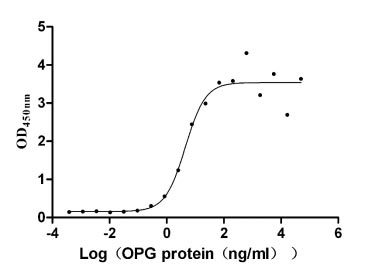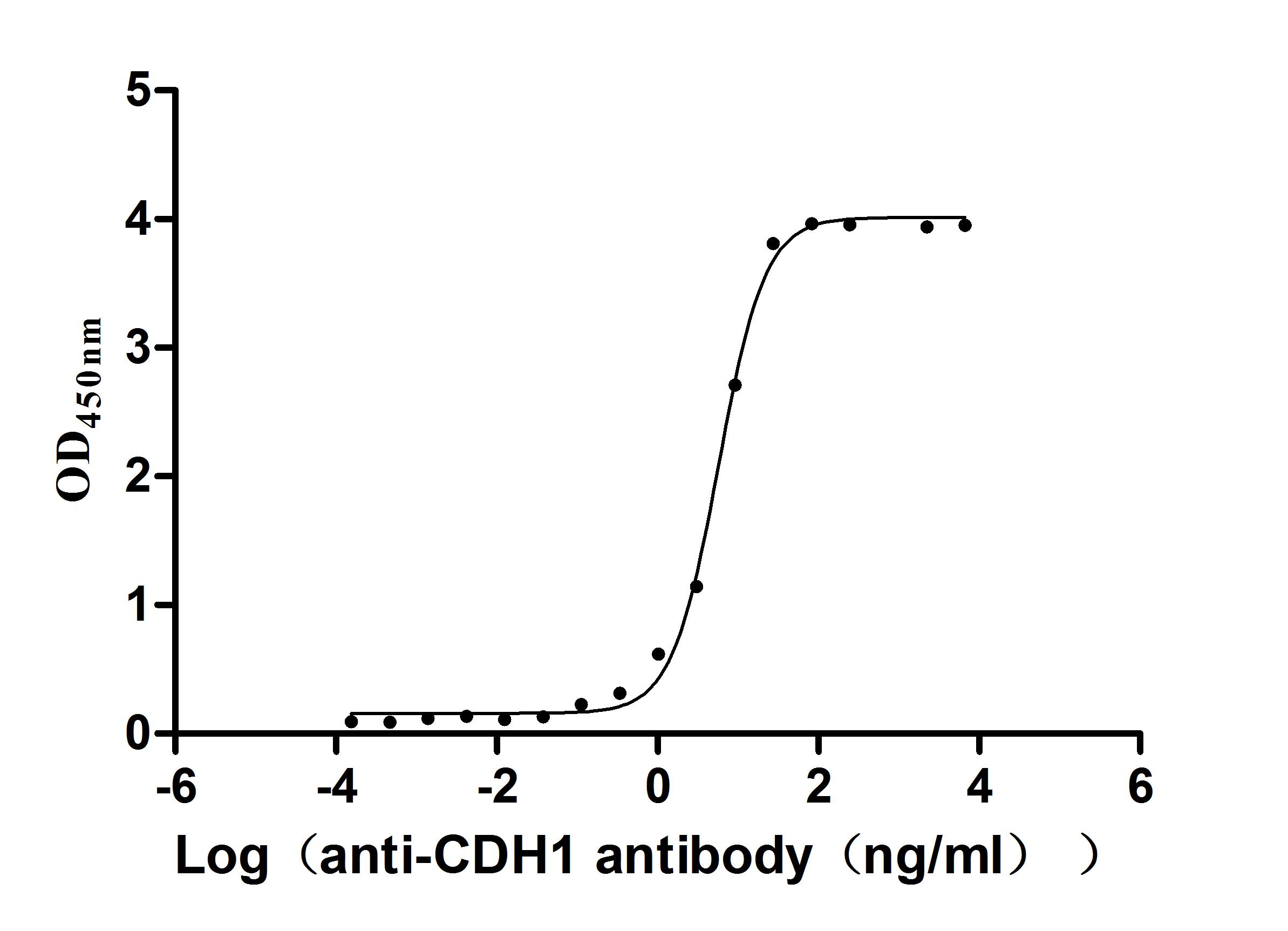Recombinant Mouse Transcription factor E2F2 (E2f2)
-
中文名称:小鼠E2f2重组蛋白
-
货号:CSB-YP007341MO
-
规格:
-
来源:Yeast
-
其他:
-
中文名称:小鼠E2f2重组蛋白
-
货号:CSB-EP007341MO
-
规格:
-
来源:E.coli
-
其他:
-
中文名称:小鼠E2f2重组蛋白
-
货号:CSB-EP007341MO-B
-
规格:
-
来源:E.coli
-
共轭:Avi-tag Biotinylated
E. coli biotin ligase (BirA) is highly specific in covalently attaching biotin to the 15 amino acid AviTag peptide. This recombinant protein was biotinylated in vivo by AviTag-BirA technology, which method is BriA catalyzes amide linkage between the biotin and the specific lysine of the AviTag.
-
其他:
-
中文名称:小鼠E2f2重组蛋白
-
货号:CSB-BP007341MO
-
规格:
-
来源:Baculovirus
-
其他:
-
中文名称:小鼠E2f2重组蛋白
-
货号:CSB-MP007341MO
-
规格:
-
来源:Mammalian cell
-
其他:
产品详情
-
纯度:>85% (SDS-PAGE)
-
基因名:
-
Uniprot No.:
-
别名:E2f2Transcription factor E2F2; E2F-2
-
种属:Mus musculus (Mouse)
-
蛋白长度:Full length protein
-
表达区域:1-443
-
氨基酸序列MLRAPRTLAP ATAQPTKSLP ALNPTELWPS GLSSPQLCPA TTATTYYTSL YTQTVPSSVA LGTCLDATPH GPEGQIVRCA PAGRLPAKRK LDLEGIGRPT VPEFRTPKGK CIRVDGLPSP KTPKSPGEKT RYDTSLGLLT KKFIYLLSES EDGVLDLNWA AEVLDVQKRR IYDITNVLEG IQLIRKKSKN NIQWVGRELF EDPTRPSRQQ QLGQELKELM NAEQTLDQLI QSCSLSFKHL TEDNANKKLA YVTYQDIRAV GNFKEQTVIA VKAPPQTRLE VPDRAEENLQ IYLKSTQGPI EVYLCPEEGQ EPDSPAKEAL PSTSALSPIP DCAQPGCSTD SGIAETIEPS VLIPQPIPPP PPPPLPPAPS LVPLEATDNM LELSHPLLQQ TEDQFLSPIL AANSPLISFS PPLDQDEYLW GMDEGEGISD LFDSYDLGDL LIN
-
蛋白标签:Tag type will be determined during the manufacturing process.
The tag type will be determined during production process. If you have specified tag type, please tell us and we will develop the specified tag preferentially. -
产品提供形式:Lyophilized powder
Note: We will preferentially ship the format that we have in stock, however, if you have any special requirement for the format, please remark your requirement when placing the order, we will prepare according to your demand. -
复溶:We recommend that this vial be briefly centrifuged prior to opening to bring the contents to the bottom. Please reconstitute protein in deionized sterile water to a concentration of 0.1-1.0 mg/mL.We recommend to add 5-50% of glycerol (final concentration) and aliquot for long-term storage at -20℃/-80℃. Our default final concentration of glycerol is 50%. Customers could use it as reference.
-
储存条件:Store at -20°C/-80°C upon receipt, aliquoting is necessary for mutiple use. Avoid repeated freeze-thaw cycles.
-
保质期:The shelf life is related to many factors, storage state, buffer ingredients, storage temperature and the stability of the protein itself.
Generally, the shelf life of liquid form is 6 months at -20°C/-80°C. The shelf life of lyophilized form is 12 months at -20°C/-80°C. -
货期:Delivery time may differ from different purchasing way or location, please kindly consult your local distributors for specific delivery time.Note: All of our proteins are default shipped with normal blue ice packs, if you request to ship with dry ice, please communicate with us in advance and extra fees will be charged.
-
注意事项:Repeated freezing and thawing is not recommended. Store working aliquots at 4°C for up to one week.
-
Datasheet :Please contact us to get it.
靶点详情
-
功能:Transcription activator that binds DNA cooperatively with DP proteins through the E2 recognition site, 5'-TTTC[CG]CGC-3' found in the promoter region of a number of genes whose products are involved in cell cycle regulation or in DNA replication. The DRTF1/E2F complex functions in the control of cell-cycle progression from g1 to s phase. E2F2 binds specifically to RB1 in a cell-cycle dependent manner.
-
基因功能参考文献:
- Genomic structure, expression pattern, and functional characterization of transcription factor E2F-2 from black tiger PMID: 28558060
- Findings implicate E2F-2 in regulating the expression of mitotic kinases that are adapted to perform specialized functions in nuclear condensation and enucleation of maturing erythroblasts. PMID: 27795297
- Spinal cord injury-induced activation of E2F1-2 mediates cell cycle activation, contributing to gliopathy and neuronal/tissue loss associated with motor impairments and post-traumatic hyperesthesia. PMID: 26505089
- E2F2 loss results in increased lung metastasis in breast cancer, potentially functioning through a PTPRD dependent mechanism. PMID: 26474282
- A role for E2F1 and E2F2 as suppressors of replicative stress in differentiating cells, and the existence of a robust E2F-p53 regulatory axis in tissue homeostasis enabling and tumorigenesis preventing is shown. PMID: 25656653
- E2F2 accumulates at sites of oxidative and UV-induced DNA damage, and interact with gammaH2AX DNA repair factor. PMID: 25892555
- E2F2 activity sustains the hepatic homeostasis of major membrane glycerolipid components while it is dispensable for storage glycerolipid balance. PMID: 25396754
- Rb-deficient cells hijack and redeploy Myc and E2f3 from an S-G2 program essential for normal cell cycles to a G1-S program that re-engages ectopic cell cycles, exposing an unanticipated addiction of Rb-null cells on Myc. PMID: 26192440
- showed that the D326V missense pRb bound to E2F1 but failed to interact with E2F2/3 PMID: 25088905
- E2F3 promotes while E2F2 suppresses ischemic cardiac repair through corresponding changes in endothelial cell proliferation. PMID: 23799044
- E2F2 impairs, and endothelial E2F3 promotes, the angiogenic response to peripheral ischemic injury through corresponding changes in EC cell-cycle progression. PMID: 23603666
- E2f2 induces cone photoreceptor apoptosis independent of E2f1 and E2f3 in mice. PMID: 23558950
- these results indicate that the transcriptional activity of E2F2 contributes to promote adult hepatocyte proliferation and liver regeneration. PMID: 21527726
- E2F1-3 in mediating transcriptional repression by retinoblastoma tumor suppressor during cell cycle exit and point to a critical role for their repressive functions in cell survival. PMID: 21185283
- functions for E2f1-3 at distinct stages of myeloid development in vivo, first as repressors in cell survival and then as activators in cell proliferation. PMID: 21115501
- loss of E2F2 results in a deregulated Aryl-hydrocarbon-receptor pathway PMID: 20573986
- Findings show that rapid proliferation of E2F1/E2F2 compound mutant cultures is temporally followed by induction of a DNA damage response and the implementation of a p21(CIP1)-dependent senescence. PMID: 20676136
- Control of miRNAs by E2F is likely to play multiple roles in cell proliferation and in proliferative diseases such as cancer. PMID: 20404092
- we have examined the effect that a simultaneous inactivation of the E2F2 gene and over-expression of the Bcl-2 gene in B cells has on lymphoid homeostasis and autoimmunity PMID: 20187704
- findings demonstrate that E2F2 can function as a tumor suppressor in epithelial tissues, perhaps by limiting proliferation in response to Myc PMID: 19798698
- loss of activating E2fs caused downregulation of the p53 deacetylase Sirt1, p53 hyperacetylation and elevated apoptosis, establishing a novel E2f-Sirt1-p53 survival axis in vivo PMID: 20016601
- In differentiating cells E2f1-3 function in a complex with Rb as repressors to silence E2f targets and facilitate exit from the cell cycle PMID: 20016602
- E2F1 and E2F2 play essential and redundant roles in the proper coordination of cell cycle progression with differentiation which is necessary for efficient hematopoiesis PMID: 12724419
- role in postnatal pancreas development and homeostatic maintenance PMID: 14566047
- E2F2 promotes unscheduled cell division and oncogenic transformation of thymic epithelial cells PMID: 14684733
- E2F1/E2F2 compound-mutant mice develop nonautoimmune insulin-deficient diabetes and exocrine pancreatic dysfunction PMID: 15146237
- A role is indicated for E2F2 in promoting T cell proliferation in response to T cell receptor (TCR) stimuli in the context of homeostatic signaling in vivo. PMID: 16002659
- the negative regulation of the p53-p21(CIP1) axis by the E2F1-3 factors is critical for cell cycle progression and cellular transformation PMID: 17008321
- a critical function of the E2F1, E2F2, and E2F3 activators is in the control of a p53-dependent axis that indirectly regulates E2F-mediated transcriptional repression and cellular proliferation PMID: 17167174
- T-antigen-induced intestinal proliferation is reduced in mice lacking either E2F2 alone or both E2F2 and E2F3a PMID: 17855529
- E2F2 has a tumor suppressor function in Myc-induced T cell lymphomagenesis PMID: 17881568
- These results implicate deregulated E2f-2 in the cell cycle defects observed in Rb null erythroblasts and reveal a novel role for E2f-2 during terminal red blood cell differentiation. PMID: 17923680
- E2F4 is important in early stages of commitment to the lymphoid lineage. PMID: 18322175
- Results suggest a model in which Erythroid Kruppel-like factor-dependent activation and modification of the E2f2 locus is required for cell cycle progression preceding terminal erythroid differentiation. PMID: 18852285
- E2F2 Transcription Factor functions to transcriptionally repress cell cycle genes to establish the G(0) state. PMID: 19066456
- E2F2 and E2F3 had positive effects on the promoter activity of fibrillin-2 in chondrocyte differentiation PMID: 19142862
- Direct regulation of the E2f2 enhancer is a generic mechanism by which many Kruppel-like factors regulate proliferation and differentiation. PMID: 19457859
- GATA-1, the master transcription factor of erythropoiesis, forms a tricomplex with the retinoblastoma protein (pRb) and E2F-2. PMID: 19513100
- The absence of E2F2 substantially accelerates Myc-induced lymphomagenesis. PMID: 19749980
- results identify a cell-cycle-independent mechanism by which E2F2 regulates endothelial function, arterial contractility, and blood pressure PMID: 19752322
- The E2F1-3 transcription factors are essential for cellular proliferation PMID: 11719808
- E2F1 and E2F2 determine thresholds for antigen-induced T-cell proliferation and suppress tumorigenesis PMID: 11713289
- Mutation of E2F2 in mice causes enhanced T lymphocyte proliferation, leading to the development of autoimmunity PMID: 11754817
显示更多
收起更多
-
亚细胞定位:Nucleus.
-
蛋白家族:E2F/DP family
-
数据库链接:
KEGG: mmu:242705
STRING: 10090.ENSMUSP00000050047
UniGene: Mm.307932
Most popular with customers
-
Recombinant Human Macrophage migration inhibitory factor (MIF) (Active)
Express system: Mammalian cell
Species: Homo sapiens (Human)
-
Recombinant Human Tumor necrosis factor receptor superfamily member 11B (TNFRSF11B) (Active)
Express system: Mammalian cell
Species: Homo sapiens (Human)
-
Recombinant Human Poliovirus receptor (PVR) (I340M), partial (Active)
Express system: Mammalian cell
Species: Homo sapiens (Human)
-
Recombinant Human V-set and immunoglobulin domain-containing protein 4 (VSIG4), partial (Active)
Express system: Mammalian cell
Species: Homo sapiens (Human)
-
Recombinant Human CD81 antigen (CD81), partial (Active)
Express system: Mammalian cell
Species: Homo sapiens (Human)
-
Recombinant Macaca fascicularis CUB domain containing protein 1 (CDCP1), partial (Active)
Express system: Mammalian cell
Species: Macaca fascicularis (Crab-eating macaque) (Cynomolgus monkey)
-
-
Recombinant Human Cadherin-1(CDH1),partial (Active)
Express system: Mammalian cell
Species: Homo sapiens (Human)




-AC1.jpg)















